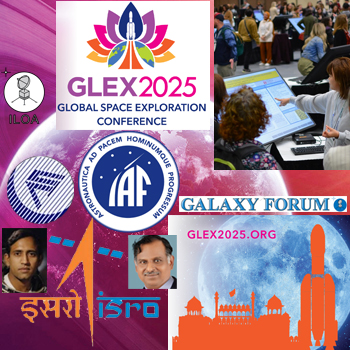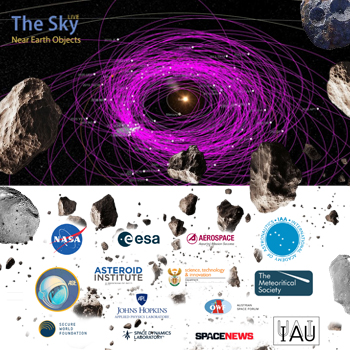India Spotlights Our Galaxy: IAF GLEX May 7-9; ILOA Galaxy Forums May 9 & 12 |
MONDAY☆ May 5 — International Space Station, ~415-km LEO: Expedition 73 seven-member crew looking forward to >30% more electrical power, 215kw instead of 160, with new solar arrays; ISS in 540-meter-higher orbit from 3-min+ burn as precaution against debris; Astronaut Jonny Kim photographing tomato plants to see if they grow without photosynthesis; Cosmonauts photographing Patagonia glaciers & other Earth regions; Ayers and Onishi speak with students on livestream today, 10:40 EDT. ☆ May 5 — Tiangong Space Station, ~390-km LEO: Shenzhou 20 three-member crew is headed by Senior Colonel Chen Dong and getting data from ground crew member Nan Hongtao on 27 precautions he noted during the Shenzhou 19 mission, crew of which are in the standard 6-month quarantine and recuperation program. ☆ May 5 — CNSA, Launch Long March 12 / Hulianwang Jishu Shiyan, Wenchang Space Launch Center, Hainan, China: Long March 12 from commercial launch pad No.2 to send test satellites for Guowang (SatNet) to LEO; will be 2nd launch from new commercial pad. ★ May 5 — SpaceX, Launch Falcon 9 / Starlink Group 6-93, SLC-40, Cape Canaveral SFS FL: Next batch of Starlink satellites to launch for mega-constellation. o May 5 — European Space Agency, Online: Proposals due for European Launcher Challenge; up to €169M available for each selected vehicle. o May 5-9 — International Academy of Astronautics, Association of Space Explorers, B612 Foundation, International Astronomical Union, SWF, JHU APL, Cape Town, South Africa: 9th IAA Planetary Defense Conference. ● May 5-9 — Space Weather Solutions, League City TX: Applied Space Environments Conference ASEC2025; US$425-700. ☆ May 5-6 — Eta Aquarids Meteor Shower Peak: 1 of 2 annual showers from passing through Halley’s Comet dust, appear to radiate from Constellation Aquarius; Northern Hemisphere may see 10+ meteors per hour, Southern Hemisphere 20-40 per hour; best viewing midnight-04:00. ☾ May 5 — Moon: 1.84° NE of Regulus, 11:00. ☆ May 5 — Mars: 0.61° NNE of Beehive Cluster, 04:00. ☆ May 5 — Apollo Asteroid 2025 FA6: Near-Earth Flyby (0.073 AU) |
 |
● = Terrestrial and o = International terrestrial events in local time; ☾ = Moon, ★ = Space and ☆ = International space events in Hawai’i time unless noted. |
Weekly Planet Watch – Morning Planets: Mercury(E), Venus (E), Saturn (E); Evening Planets: Mars (SW), Jupiter (W).
Cape Town, South Africa 9th IAA Planetary Defense Conference Focuses on NEOs and Risk Management
The 9th IAA Planetary Defense Conference (PDC 2025) in Stellenbosch, Cape Town, South Africa from May 5-9 features 265+ abstracts. This biannual meeting is sponsored by International Academy of Astronautics, NASA, ESA, Aerospace Corporation, Association of Space Explorers, B612 Foundation, International Astronomical Union, SWF, JHU APL, and others. The symposium will cover topics related to the detection and monitoring of Near-Earth Objects that pose potential threats to Earth, the characteristics of these celestial bodies, strategies for deflecting / disrupting any identified threats, the nature of impact-related disasters, and the political, legal and policy considerations for comprehensive mitigation strategies. NASA Double Asteroid Redirection Test (DART) was the first planetary defense technology demonstration and successfully impacted its target, asteroid Dimorphos. The impact reduced its orbital period around its companion asteroid by ~33 minutes, but unexpectedly up to ~1% of Dimorphos mass was ejected and 8% of its mass was redistributed. The unpredicted reshaping of the asteroid highlights the need for asteroid observation and modeling. Some of these observations are already happening from Earth: Pan-STARRS (Hawai’i), Catalina Sky Survey (Arizona), and ATLAS (Asteroid Terrestrial-impact Last Alert System) in Hawai’i and Chile. Other studies are occurring from space: Lucy, Psyche, Hera, NEOWISE, OSIRIS-REx, Hayabusa2 and soon-to-be- launched Tianwen-2. Eventually, Earth surveys for planetary protection could be placed on the surface of the Moon. (Image Credits: IAA, NASA, ESA, The Sky Live, et al) |
Ongoing… ☾ Jan 15 – Jun 5+ — Hakuto-R M2 Resilience, Elliptical Lunar Orbit: ispace Japan lander en route to land on Moon June 5 at Mare Frigoris, ~60.5°N, 4.6°W; carries ~5-kg micro-rover and other payloads; launched from FL Jan 15; lunar orbit insertion expected May 7. ☆ NET May — Gilmour Space, Launch Eris Block 1 / Test flight, Eris Pad, Bowen Orbital Spaceport, Queensland, Australia: First flight of 3-stage orbital rocket to deliver up to ~300 kg to LEO; first launch from Bowen Spaceport. o May 4-8 — International Academy of Astronautics (IAA), Berlin, Germany: 15th IAA Symposium on Small Satellites for Earth System Observation. TUESDAY☆ May 6 — Apollo Asteroid 2025 HF5: Near-Earth Flyby (0.009 AU) WEDNESDAY● May 7 — LPI, USRA, NASA, Online / Houston TX: Lunar Surface Science Workshop 27: Artemis Community Forum; communicating aspects of ongoing activities relating to the Artemis campaign. o May 7 — EuroPlanet, American Astronomical Society, Online / Helsinki, Finland: Abstracts due for EPSC-DPS 2025 (EuroPlanet Science Congress) to be held Sep 7-12; includes session TP11, Lunar Space Environment. ● May 7 — NASA, Online / Washington DC: Registrations due for information webinar concerning all 2025 NASA student internships. o May 7-9 — International Astronautical Federation, New Delhi, India: Global Space Exploration Conference (GLEX 2025); Global Networking Forum session “ILOA-ILEWG Galaxy Forum International NewSpace to the Moon” featured on May 9 at 12:00 IST; at Yashobhoomi (India International Convention & Expo Centre). ☆ May 7 — Apollo Asteroid 2025 HY2: Near-Earth Flyby (0.045 AU) |
THURSDAY
★ May 8 — Juno, Perijove 72 / 71st Science Flyby, Jupiter Orbit: NASA craft to perform Jupiter flyby during Perijove 72, its 72nd close flyby of Jupiter and 71st science flyby with instruments turned on.
☆ May 8 — Aten Asteroid 2021 HZ: Near-Earth Flyby (0.051 AU)
FRIDAY
★ May 9 — SpaceX, Launch Falcon 9 / Starlink Group 15-4, SLC-4E, Vandenberg SFB CA: Batch of satellites for Starlink mega-constellation space-based Internet communication system.
o May 9 — Royal Astronomical Society, London, United Kingdom: Annual General Meeting for Fellows Only and Presidential Address 2025; 15:30-18:00 BST.
☾ May 9 — Moon: 0.39° S of Spica, 23:00.
☆ May 9 — Aten Asteroid 612356 (2002 JX8): Near-Earth Flyby (0.028 AU)
SATURDAY
☾ May 10 — Moon: At apogee (distance 406,225 km), 15:00.
☆ May 10 — Apollo Asteroid 2021 KH: Near-Earth Flyby (0.046 AU)
SUNDAY
☆ May 11 — Aten Asteroid 2014 QZ295: Near-Earth Flyby (0.094 AU)

